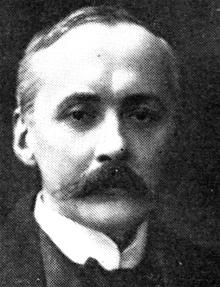
John James Burnet [also known as Sir John James Burnet] was born in Glasgow, Scotland on 31 March 1857. After training in the office of his father, John Burnet (1814-1901) in 1871-72, he studied at the Ecole des Beaux-Arts in Paris from 1872. Whist in Paris he was a pupil of Jean-Louis Pascal (1837-1920) and worked with François Rolland. In 1876 he returned to his father's office, and from 1882 worked in partnership with his father as John Burnet & Son. In 1886 John Archibald Campbell (1859-1909) joined the firm which then renamed John Burnet, Son & Campbell. The association with Campbell was dissolved in 1897, and the practice reverted to its previous name, John Burnet & Son. Meanwhile, by then John Burnet had retired. Following the death of his father in 1901, John James Burnet continued the practice with the title unchanged.
In 1919, Thomas Tait (1882-1954), who had worked as Burnet's chief assistant, and David Raeside (1882-1930), his office manager, were taken into partnership and the practice title was changed to Sir John Burnet & Partners.
John James Burne was elected an Associate of the Royal Institute of British Architects (ARIBA) in 1881 and a Fellow of the Royal Institute of British Architects (FRIBA) in 1897. In 1923 he was awarded the RIBA Royal Gold Medal. In 1897 he was President of the Glasgow Institute of Architects. He died in Edinburgh on 2 July 1938.
Royal Institute of Fine Arts, Glasgow (1881); head offices of Clyde Navigation Trust, Glasgow (1883-80, 1900-9); Edinburgh International Exhibition (1886); Barony Parish Church, Glasgow (1886-89, 1898-1900); Glasgow Atheneum (1889, 1890,1891-93); the Barony Church, Glasgow (1890); Arbroath Parish Church (1894-96); head offices, Savings Bank of Glasgow (1894-1900;) extensions to Western Infirmary, Glasgow (1894-1923); Glasgow Central Railway: Glasgow Cross Station (1895); Anderson Cross Station , Glasgow (1895); Botanic Gardens, Glasgow (1895); Loch Ranza Hotel, Arran (1895); Alloa Public Baths (1895-99); extensions to University, Glasgow, Students Union (1895-1923); Gardner Memorial Church, Brechin (1896-1900); Parish Church, Arbroath (1897); Central Station (Low Level), Glasgow (1897-1900); the McLaren Memorial Church and Manse, Stenhousemuir, Larbert (1897-1900); Glasgow Royal Asylum. extensions (1898-1901); Gardner Memorial Church, Brechin (1898); Parish Church, Lossiemouth (1899-1903); Atlantic and Waterloo Chambers, Glasgow (1899-1908); McLaren Memorial Church, Larbert (1900); Drumshough Baths, Edinburgh (1900); Atlantic and Waterloo Chambers, Glasgow (1900); Parish Church, Rutherglen (1900-02); Broomhill Congregational Church, Glasgow (1900-08); Wemyss Bay Church (1900-08); Charing Cross Mansions, Glasgow (1901); British Museum extension, London (1905-14); premises for R. W. Forsyth, Princes Street, Edinburgh (1906-10, 1923); Cumberland Infirmary, Carlisle, extensions (1908-13); Alhambra Theatre, Glasgow (1910-12, 1914-15, 1920-22); Royal Hospital for Sick Children, Glasgow (1911-16); Duart Castle, Isle of Mull, restoration (1911-16); General Accident Assurance Co.'s Building, Aldwych, London (1912); Kilmarnock Infirmary (1912-16, 1922); Kodak Building, Kingsway, London (1913); Wallace Scott and Company's Warehouse, Cathcart, Glasgow (1913-22); Selfridge Extension, London (1914-23); scheme for lay-out of sea-front, Ramsgate (East Cliff Gardens), (1919-28); Adelaide House, London Bridge (1920-23); Second Church of Christ Scientist and Sunday School and office buildings, Palace Gardens Terrace, London (1921-23); decoration of the Merchant Taylors Company's Hall, London; Vigo House, corner of Regent Street and Vigo Street, London (c.1923-24); Glasgow Cenotaph, George Square, Glasgow (1924); Hunter Memorial, University of Glasgow (1924); Adelaide House, London Bridge Approach, London (1925); Daily Telegraph Building, Fleet Street, London (1925); North British & Mercantile Assurance, 200 St Vincent Street, Glasgow (1925); Lloyds Bank, Lombard Street, London (1927); Sydney Harbour Bridge, (1929); University of Glasgow Memorial Chapel (1929); and, with James Lomax-Simpson (1882-1977), Unilever House, Blackfriars, London (1930–33). Burnet was also commissioned to design war memorials for Gallipoli and Jerusalem.
_______
See also:
The Architectural Work of Sir John Burnet and Partners (Sir John J. Burnet ... Thomas S. Tait ... and the late David Raeside) With preface by A. Trystan Edwards. Geneva: Masters of Architecture, 1930
Burnet, John James. 'The Royal Gold Medal Address'. Journal of the Royal Institute of British Architects vol. 30, 1923 pp. 513-514
Directory of British Architects 1834-1914. Compiled by Antonia Brodie, et al. Volume 1: A-K. London; New York: British Architectural Library, Royal Institute of British Architects/Continuum, 2001
Emberton, Joseph. 'Adelaide House'. Architect vol. 113, 9 January 1925 pp. 24-31 [Discusses Adelaide House, London designed by John Burnet & Partners]
Fyfe, Theodore. ‘Obituary’. Royal Institute of British Architects Journal vol. 45, 15 August 1938 pp. 941-943, 993
Gomme, Andor Harvey and Walker, David. Architecture of Glasgow. London: Lund Humphries, 2nd, revised, edition, 1987
Goodhart-Rendal, Harry Stuart. 'The work of Sir John Burnet'. Architects' Journal vol. 57, 27 June 1923 pp. 1065-1110
Gray, A. Stuart. Edwardian architecture: a biographical dictionary. London: Gerald Duckworth & Co., Ltd., 1985
Marriott, Charles. Modern English Architecture. London: Chapman & Hall, 1924
McAslan, John. 'J. J. Burnet' in Macmillan Encyclopedia of Architects Volume 1. Edited by Adolf K. Plakzek. New York and London: Macmillan and Free Press, 1982 pp. 351-352
‘Obituary’. Architect & Building News vol. 155, 8 July 1938 pp. 29, 31
‘Obituary’. Architect’s Journal vol. 88, 7 July 1938 p. 6
‘Obituary’. Builder vol. 155, 8 July 1938 pp. 53, 59, 104
Paterson, A.N. and Tait, T.S .‘Obituary’. Royal Institute of British Architects Journal vol. 45, 18 July 1938 pp. 893-896
Rankin, Robert. 'Sir John Burnet and His Works'. Royal Incorporation of Architects in Scotland Journal vol. 94, no. 6, 1953 pp. 27-39
Rees, Verner O. 'Glasgow University Zooological Building' Architects' Journal vol. 66, 21 September 1927 pp. 383-387 [Designed by John James Burnet]
Robertson, Howard. 'Two Great London Buildings of 1924'. Architects' Journal vol. 61, 7 January 1925 pp. 4-12 Adelaide House by John Burnet & Partners, and Britannic House by Edwin L. Lutyens]
Service, Alastair. The Architects of London and their buildings from 1066 to the present. London: The Architectural Press, 1979
Walker, David 'Sir John James Burnet' in Edwardian Architecture and its Origins. Edited by Alastair Service. London: The Architectural Press Ltd., 1975 pp. 192-215
Who's Who in Architecture 1914. London: Technical Journals Ltd., 1914
Who's Who in Architecture 1923. Edited by Frederick Chatterton. London: The Architectural Press, 1923